(2S,3S,4R)-2-CARBOXY-4-ISOPROPYL-3-PYRROLIDINEACETIC ACID
Synonym(s):2-Carboxy-4-isopropyl-3-pyrrolidineacetic acid
- CAS NO.:52497-36-6
- Empirical Formula: C10H17NO4
- Molecular Weight: 215.25
- MDL number: MFCD03412037
- SAFETY DATA SHEET (SDS)
- Update Date: 2024-10-23 13:36:13
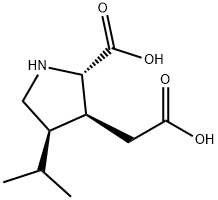
What is (2S,3S,4R)-2-CARBOXY-4-ISOPROPYL-3-PYRROLIDINEACETIC ACID?
Description
Dihydrokainic acid (DHK) is an inhibitor of excitatory amino acid transporter 2 (EAAT2; Ki = 23 μM for glutamate uptake by COS cells expressing EAAT2). It is selective for EEAT2 over EAAT1 and EAAT3 (Ki = >3 mM for both). DHK microinfusion (5 nmol) into the rat infralimbic cortex reduces the time spent immobile in the forced swim test, indicating antidepressant-like behavior, an effect that is blocked by the AMPA receptor antagonist NBQX and the serotonin (5-HT) receptor subtype 5-HT1A antagonist WAY-100635 . It also increases glutamate and serotonin levels and the expression of c-Fos in the dorsal raphe nucleus. In contrast, DHK microinjection (6.25 nmol) into the rat prefrontal cortex (PFC) increases the latency to drink sucrose in a sucrose intake test, indicating anhedonia-like behavior. It also impairs memory acquisition, consolidation, and retrieval in mice in the novel object recognition test.
The Uses of (2S,3S,4R)-2-CARBOXY-4-ISOPROPYL-3-PYRROLIDINEACETIC ACID
Dihydrokainic acid has been used as a glutamate transporter (GLT-1) inhibitor in the glutamate uptake assay of astrocytes and glial cells. It may be used as a GLT-1 inhibitor in Lateral habenula (LHb).
What are the applications of Application
Dihydrokainic acid is an EAAT2(GLT1)-selective non-transportable inhibitor of L-glutamate and L-aspartate uptake
Definition
ChEBI: Dihydrokainic acid is a dicarboxylic acid. It is functionally related to a kainic acid.
Biological Activity
EAAT2(GLT1)-selective non-transportable inhibitor of L-glutamate and L-aspartate uptake (K i = 23 μ M). 130-fold selective over EAAT1 and EAAT3 (K i > 3 mM). Also available as part of the Excitatory Amino Acid Transporter Inhibitor Tocriset™ .
Biochem/physiol Actions
Dihydrokainic favors neuronal cell death. It modulates anxiety and depression behaviors.
storage
Room temperature
Properties of (2S,3S,4R)-2-CARBOXY-4-ISOPROPYL-3-PYRROLIDINEACETIC ACID
| Melting point: | 285 °C (decomp) |
| Boiling point: | 416.6±30.0 °C(Predicted) |
| Density | 1.187±0.06 g/cm3(Predicted) |
| storage temp. | 2-8°C |
| solubility | H2O: >10 mg/mL |
| form | solid |
| pka | 2.11±0.60(Predicted) |
| color | White |
| Water Solubility | Soluble to 25 mM in water |
Safety information for (2S,3S,4R)-2-CARBOXY-4-ISOPROPYL-3-PYRROLIDINEACETIC ACID
Computed Descriptors for (2S,3S,4R)-2-CARBOXY-4-ISOPROPYL-3-PYRROLIDINEACETIC ACID
New Products
4-Fluorophenylacetic acid 4-Methylphenylacetic acid N-Boc-D-alaninol N-BOC-D/L-ALANINOL Tert-butyl bis(2-chloroethyl)carbamate 3-Morpholino-1-(4-nitrophenyl)-5,6-dihydropyridin- 2(1H)-one Furan-2,5-Dicarboxylic Acid Tropic acid S-2-CHLORO PROPIONIC ACID ETHYL ISOCYANOACETATE 2-Bromo-1,3-Bis(Dimethylamino)Trimethinium Hexafluorophosphate (6-METHYL-[1,3]DITHIOLO[4,5-b]QUINOXALIN-2-ONE INDAZOLE-3-CARBOXYLIC ACID 4-IODO BENZOIC ACID (2-Hydroxyphenyl)acetonitrile 4-Bromopyrazole 5,6-Dimethoxyindanone 2-(Cyanocyclohexyl)acetic acid 4-methoxy-3,5-dinitropyridine 2-aminopropyl benzoate hydrochloride 1-(4-(aminomethyl)benzyl)urea hydrochloride diethyl 2-(2-((tertbutoxycarbonyl)amino) ethyl)malonate tert-butyl 4- (ureidomethyl)benzylcarbamate Ethyl-2-chloro((4-methoxyphenyl)hydrazono)acetateRelated products of tetrahydrofuran

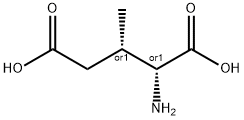


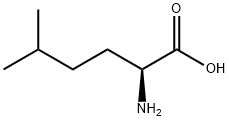
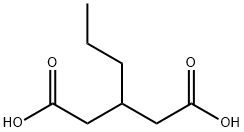
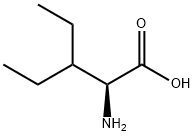
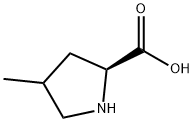
You may like
-
 Dihydrokainic acid CAS 52497-36-6View Details
Dihydrokainic acid CAS 52497-36-6View Details
52497-36-6 -
 2033-24-1 98%View Details
2033-24-1 98%View Details
2033-24-1 -
 1975-50-4 98%View Details
1975-50-4 98%View Details
1975-50-4 -
 2-HYDROXY BENZYL ALCOHOL 98%View Details
2-HYDROXY BENZYL ALCOHOL 98%View Details
90-01-7 -
 2-Chloro-1,3-Bis(Dimethylamino)Trimethinium Hexafluorophosphate 221615-75-4 98%View Details
2-Chloro-1,3-Bis(Dimethylamino)Trimethinium Hexafluorophosphate 221615-75-4 98%View Details
221615-75-4 -
 61397-56-6 CIS BROMO BENZOATE 98%View Details
61397-56-6 CIS BROMO BENZOATE 98%View Details
61397-56-6 -
 14714-50-2 (2-Hydroxyphenyl)acetonitrile 98+View Details
14714-50-2 (2-Hydroxyphenyl)acetonitrile 98+View Details
14714-50-2 -
 118753-70-1 98+View Details
118753-70-1 98+View Details
118753-70-1